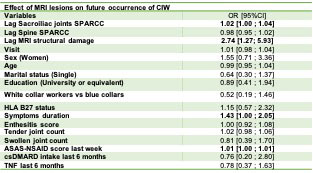Session Information
Date: Sunday, November 13, 2022
Title: Spondyloarthritis Including PsA – Diagnosis, Manifestations, and Outcomes Poster III
Session Type: Poster Session C
Session Time: 1:00PM-3:00PM
Background/Purpose: A definition for clinically important worsening (CIW) of axial Spondyloarthritis (axSpA) has been proposed by ASAS: i.e. an increase of ≥0.9 points of ASDAS. However, it is unknown how this definition performs in an early axSpA cohort.
The aim of this study was to determine the prevalence of CIW in a population of early axSpA, as well as the association between the occurrence of CIW and the presence of concomitant signs of inflammation; finally, to determine whether MRI inflammation was predictive of a future CIW.
Methods: 708 patients with early axSpA from the French DESIR cohort were included in the analysis. Patients were followed every 6 months for the first 2 years and annually thereafter. All patients had an MRI of spine and sacroiliac joints at baseline, but only patients from the APHP centers performed those at 2 and 5 years. Prevalence of CIW was calculated during the 5 years of follow-up in the cohort. The association between CIW and concomitant objective signs of inflammation (such as swollen joint count) was assessed over time using mixed models adjusted for sociodemographic and other clinical covariates. CIW predictive factors including the predictive capacity of MRI inflammation (measured by SPARCC at SIJ and spine) and MRI structural damage (defined by presence of ≥5 structural lesions of SI joints or spine) on the occurrence of a future CIW (time-lagged models) were evaluated.
Results: Total number of CIW was 378 in 5 years with 42.8% (303/708) of patients presenting at least one CIW during the follow-up. There were no significant sociodemographic or clinical differences at inclusion between patients with at least one episode of CIW and those without CIW during follow-up.
In the association models, concomitant tender joint count (OR 1.02, CI95%[1.00; 1.03]) and ASAS-NSAID score last week (OR 1.00, CI95%[1.00; 1.01]) were significantly associated with CIW over time. Presence of MRI-SIJ inflammation (OR (per SPARCC point) 1.02, CI95%[1.01; 1.04]) and MRI-SIJ structural damage (OR 2.74, CI95%[1.27; 5.93]) were predictive of future (next visit) occurrence of CIW.
Conclusion: Patients with CIW according to the ASAS definition had significantly more objective signs of inflammation concomitantly but also over time. These data support the construct validity of this definition of CIW in an early axSpA population. MRI-SIJ inflammation and structural damage may have a predictive role in the subsequent occurrence of CIW.
To cite this abstract in AMA style:
Hamitouche F, Kumaradev S, van der Heijde D, Ramiro S, Sepriano A, Molto A. Determinants of Clinically Important Worsening in Early Axial Spondyloarthritis: Analysis of the DESIR Cohort over 5 Years [abstract]. Arthritis Rheumatol. 2022; 74 (suppl 9). https://acrabstracts.org/abstract/determinants-of-clinically-important-worsening-in-early-axial-spondyloarthritis-analysis-of-the-desir-cohort-over-5-years/. Accessed .« Back to ACR Convergence 2022
ACR Meeting Abstracts - https://acrabstracts.org/abstract/determinants-of-clinically-important-worsening-in-early-axial-spondyloarthritis-analysis-of-the-desir-cohort-over-5-years/


